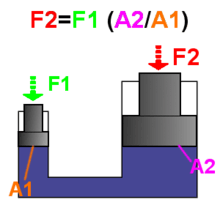Hydraulic press
A hydraulic press is a machine press using a hydraulic cylinder to generate a compressive force.[1] It uses the hydraulic equivalent of a mechanical lever, and was also known as a Bramah press after the inventor, Joseph Bramah, of England.[2] He invented and was issued a patent on this press in 1795. As Bramah (who is also known for his development of the flush toilet) installed toilets, he studied the existing literature on the motion of fluids and put this knowledge into the development of the press.[3]

Main principle
The hydraulic press depends on Pascal's principle-the pressure throughout a closed system is constant. One part of the system is a piston acting as a pump, with a modest mechanical force acting on a small cross-sectional area; the other part is a piston with a larger area which generates a correspondingly large mechanical force. Only small-diameter tubing (which more easily resists pressure) is needed if the pump is separated from the press cylinder.
Pascal's law: Pressure on a confined fluid is transmitted undiminished and acts with equal force on equal areas and at 90 degrees to the container wall.
Pressure of fluid due to the application force F1
(1)
Resulting force F2 on the larger cylinder due to the pressure of the fluid. With A1 and A2 being the areas of cylinder 1 and 2 respectively.
(2)
(3)
A small effort force acts on a small piston. This creates a pressure which is transferred through the hydraulic fluid to apply a greater force on the larger piston.[4]
Application
Hydraulic presses are commonly used for forging, clinching, moulding, blanking, punching, deep drawing, and metal forming operations.[5][6] The hydraulic press is advantageous in manufacturing, it gives the ability to create more intricate shapes and can be economical with materials.[7] A hydraulic press will take up less space compared to a mechanical press of the same capability.[8]

In popular culture
The room featured in Fermat's Room has a design similar to that of a hydraulic press.[9] Boris Artzybasheff also created a drawing of a hydraulic press, in which the press was created out of the shape of a robot. In 2015, the Hydraulic Press Channel, a YouTube channel dedicated to crushing objects with a hydraulic press, was created by Lauri Vuohensilta, a factory owner from Tampere, Finland.[10] The Hydraulic Press Channel has since grown to over 2 million subscribers on YouTube.
A hydraulic press features prominently in the Sherlock Holmes story "The Adventure of the Engineer's Thumb".
References
- "What is a Hydraulic Press?". XRF. 2018-02-08. Retrieved 2019-09-16.
- Parker, Dana T. Building Victory: Aircraft Manufacturing in the Los Angeles Area in World War II, p. 87, Cypress, CA, 2013. ISBN 978-0-9897906-0-4.
- Carlisle, Rodney (2004). Scientific American Inventions and Discoveries, p. 266. John Wiley & Sons, Inc., New Jersey. ISBN 0-471-24410-4.
- Phelan, Richard M. (2014). "Hydraulic press". Access Science. doi:10.1036/1097-8542.327000.
- Hydraulic Press Demo, retrieved 2019-09-16
- "Advantages of Hydraulic Presses". MetalFormingFacts.com. The Lubrizol Corporation. 4 February 2013. Archived from the original on 20 October 2013. Retrieved 23 August 2013.
- Nakagawa, Takeo; Nakamura, Kazubiko; Amino, Hiroyuki (1997-11-01). "Various applications of hydraulic counter-pressure deep drawing". Journal of Materials Processing Technology. 71 (1): 160–167. doi:10.1016/S0924-0136(97)00163-5. ISSN 0924-0136.
- "How It Works With The Hydraulic Press". www.hydraulicmania.com. Retrieved 2019-09-16.
- "What Hydraulic Press Machine Is". BPThai. Retrieved 2016-06-19.
- "Welcome to the 'Hydraulic Press' YouTube channel, a truly crushing experience". The Washington Post. Retrieved 2016-06-01.
External links
| Wikimedia Commons has media related to Hydraulic presses. |